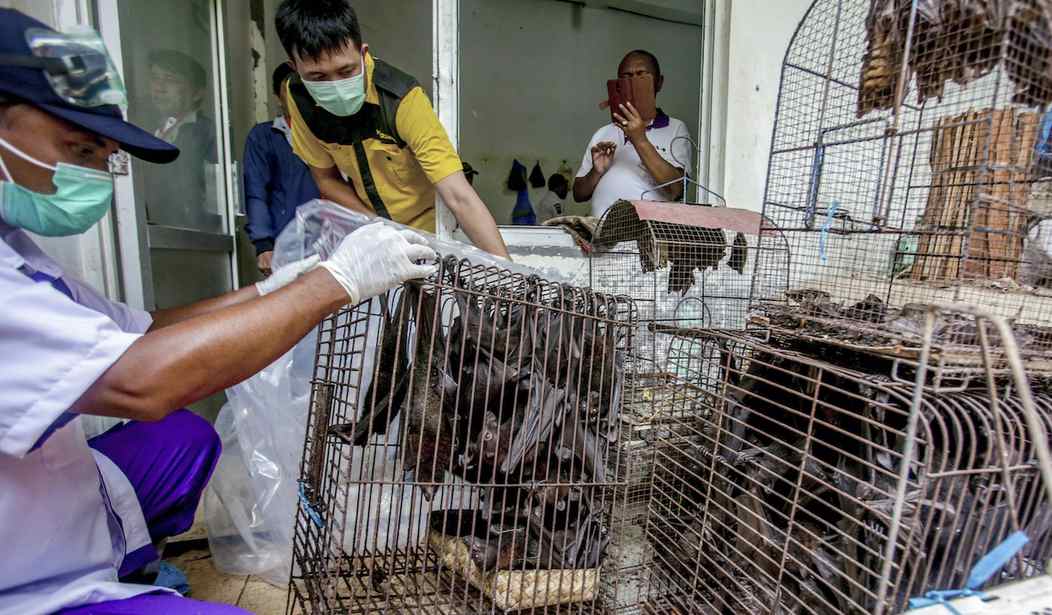It seems like it’s getting harder and harder to “follow the science” these days. That’s particularly true when you’re looking for answers but those answers change depending on which scientist you ask. For example, did the novel coronavirus escape from a lab in Wuhan or is the bat soup theory more likely to be the right one? In the past couple of months, while no concrete determinations have been forthcoming, a growing number of analysts have been leaning toward the lab leak origin story. But now, a new study being released this week suggests that a variety of coronavirus strains, including the one that causes COVID, may be making the jump from bats to humans hundreds of thousands of times every year. They’ve also provided a map of the places where such transmissions are most likely to happen. (Science Journal. Content warning: They have some seriously creepy pictures of bats in that article.)
Only two new coronaviruses have spread globally the past 2 decades: SARS-CoV, which caused an outbreak of severe acute respiratory syndrome (SARS) in 2003, and SARS-CoV-2, the virus that causes COVID-19. But that may just be the tip of the iceberg of undetected infections with related viruses emerging from bats, a new paper claims. In a preprint published yesterday researchers estimate that an average of 400,000 people are likely infected with SARS-related coronaviruses every year, in spillovers that never grow into detectable outbreaks.
Although that number comes with big caveats, “It should be eye-opening to the entire scientific community that we don’t know very much about the frequency of zoonotic spillover,” says virologist Angela Rasmussen of the University of Saskatchewan, who was not involved in the work. That needs to change, she says, “because otherwise we grossly underestimate it.”
That certainly sounds alarming at first glance, but questions were being raised about this study before it was even officially released. One factor is the identities of the study’s primary authors, Peter Daszak from the EcoHealth Alliance and Linfa Wang from Duke-NUS Medical School in Singapore. Daszak is described in the article as “a vocal advocate of the hypothesis that SARS-CoV-2 came from the wild instead of a research lab.” This makes one wonder if he approached the question with a desired outcome already in mind.
But other scientists brought up other reasons for potential skepticism. Virologist Angela Rasmussen, quoted above, goes on to note that the confidence interval on this data stretches into the hundreds of millions. Another virologist at the U.S. National Institute of Allergy and Infectious Diseases points out that “the assays used to test for antibodies can easily lead to false positives.” A third epidemiologist at the University of Toronto calls the data shaky, saying “I think if the seroprevalence estimate is way off, the whole thing collapses.”
Looking over the numbers in the summary of the study, even the layman might raise some questions. If there are nearly half a million “spillover” infections spread across most of Asia every year, how is it that we’ve only identified one place where SARS broke out and one where COVID showed up initially? Granted, the study looks at a lot of different viruses, many of which aren’t very transmissible between humans after they manage to make the initial jump, but wouldn’t the odds suggest that we’d have a lot more pandemics going at the moment if it was really all that common?
We’ll need to wait until a lot more scientists have had a chance to review this material before jumping to any conclusions. But in case you’re wondering if you’re in one of the areas where these bat-to-human transfers are the most common, there is a map on the linked page. They happen in places where bats and humans come in contact most often as you would expect. At the top of the list are southern China, Vietnam, Cambodia, and Java. Lower, but still measurable transmission rates are found in northern India, Nepal, and Myanmar. But if you can manage to avoid coming in contact with a lot of bats, you should be fine.







Join the conversation as a VIP Member